Will Mexico Pay for the Wall?
The answer is, of course, no. Really, this is a post about the wall as policy.
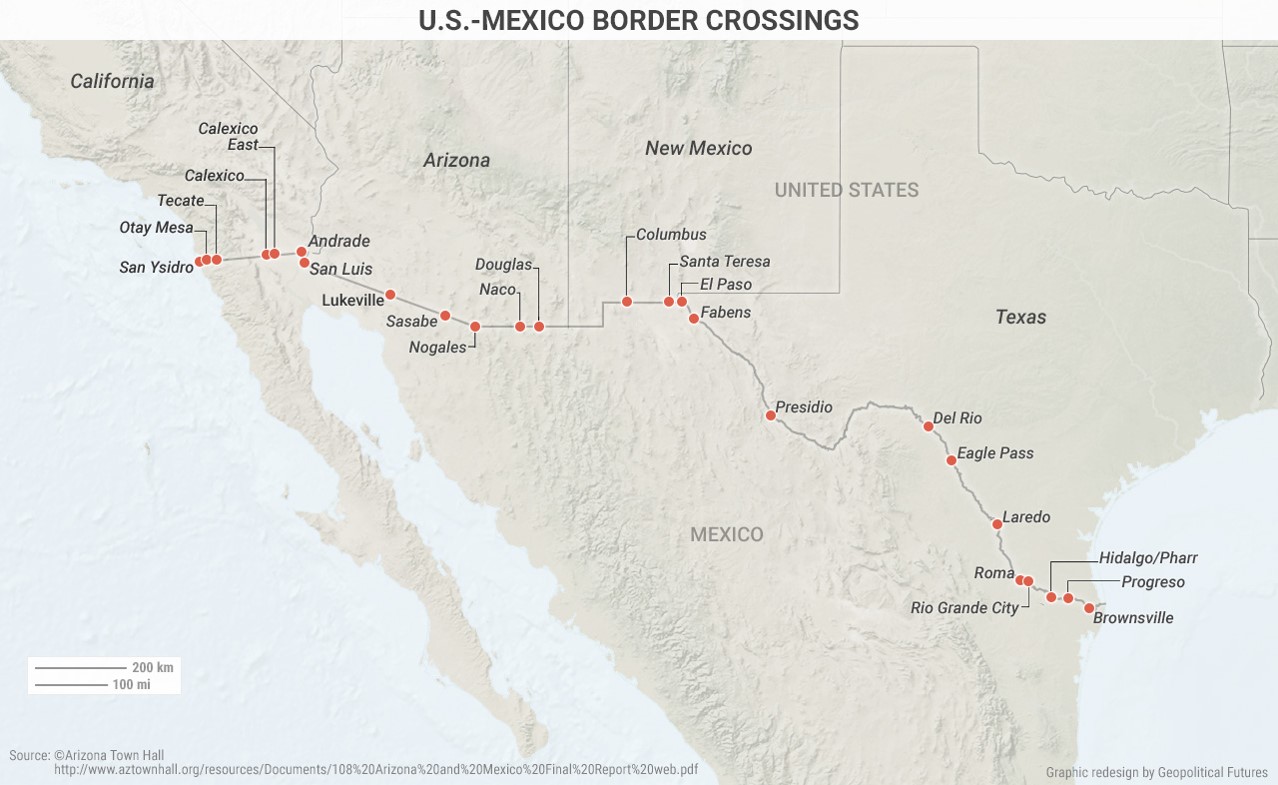 (I actually started this post as part of an extended example of my post Teaching Political Science and the Trump Administration, but it really was getting too long, so here we go…).
(I actually started this post as part of an extended example of my post Teaching Political Science and the Trump Administration, but it really was getting too long, so here we go…).
If we want to talk about an excellent example of policy that is, for me at least, impossible to teach/discuss in a detached way, it is the border wall. The reason is that the notion of a 30-foot high, 1954-mile long wall is, if one exams the topic in any detail, an absurd policy goal. It is absurd because the cost far outweighs the benefit, and, worse, it will not accomplish its policy goals. This is a recent example, insofar as I gave a talk this week to a student group entitled “Will Mexico Pay for the Border Wall.” Not to keep everyone in suspense, but the answer to the question is a bilingual one: “no.” Indeed, even the question, which derives from repeated promised by President Trump, is absurd on its face. There is absolutely no motivation (or ability) of the Mexican government to pay for a border wall. It is an utterly ridiculous promise that demonstrates an inherently flawed understanding of basic international relations.
But, like the complexity of health care, Trumps’ claims about border security do provide a pathway for teaching, although it is largely impossible to be objective about the policy itself–if, “objective” means acting like all policy options are equal or, at least, reasonable. To me, Trump’s border wall proposal is only marginally more reasonable than proposing “let’s just develop force field technology on the border” or “let’s dig a border trench.” There is a point at which it is not unreasonable to treat unreasonable policy proposals as unreasonable. And yes, a border wall is more feasible than a force field or a trench, but only barely. (If it makes anyone feel better, I have long had a similar problem about US drug war policy: an analysis of the cost/benefit suggests that it is a failed policy, and I do not pretend otherwise in class).
I can certainly note, and agree, that a 30-foot high, 1954-mile long border would lessen foot traffic across the border. My point is that it will not stop persons from entering the US undocumented, and it will most certainly not stop drug imports. It will decidedly not be worth the cost.
First, roughly half of persons without appropriate documents in the US are visa-overstayers. They entered legally. No wall, regardless of height or or length, will solve that issue. Such a situation will continue no matter whether there is a wall or not. Any real policy solution needs to demonstrate understanding of that fact.
Second, smuggling into the US will continue regardless of a wall. People can still go under the wall, for example (there have been discovered 183 tunnels under the border from 1990-2015). I would suspect if a wall were built, people would also find ways over and through as well. A wall would also just increase smuggling via legal crossings. Let’s not forget the coasts as well (the Texas coast, in particular, strikes me as a serious temptation for smugglers).
Third, the wall’s efficacy in regards to the drug trade (which the president has claimed would be part of its function) would be practically nil. Most drugs enter the US via legitimate routes or via routes that have nothing to do with walking across the Sonoran desert. While some drugs are walked across, it is far more efficient to smuggle them with legitimate products. The drugs are getting in, and a wall won’t stop them.
So, at a minimum, if a wall won’t stop drugs at all, and millions of the undocumented are visa over-stayers then these two factors alone raise the question of whether the border wall is worth the money (and all policy requires a cost/benefit calculation).
I would note, for example, that a lot of the Central Americans who cross purposefully go to legal crossing points to seek asylum. They are not going to be stopped by a wall, either. Since Central American migration is currently the main driver of border apprehensions, this pattern of behavior undercuts the wall proposal as well. It is not hyperbole to note that Mexican migrants frequently risk death crossing the Sonoran desert on foot for the privilege of getting a job cleaning bathrooms at a McDonald’s and Central Americans will undertake a ~3,000 mile journey to escape poverty and crime. Walls are unlikely to fully deter them.
So, even if one allows, as I do, that the wall will stop some people, it will not stop huge percentages of the policy problem it purports to solve. A border wall will not utterly seal the border from illegal crossings, nor will it end illegality via the border–so if anyone who supports the policy thinks that that will be outcome, they are simply mistaken. No policy will “seal the border” nor will the US government ever have 100% control of what happens along that vast a space.
Here are some numbers and images of relevance:
Let’s start with this graph, that Adam Isacson tweeted recently:
First, note that we are approaching two decades since the peak of illegal border crossing apprehensions. Also note the significant decline in Mexican nationals being caught and the increase in Central Americans. I would suggest that the decrease in Mexicans crossing is the result of a combination of factors, including improvements in the Mexican economy, the Great Recession (see 2008 onward on the chart), and improved security (including some increased pressure on employers due to the 1996 “Illegal Immigration Reform and Immigrant Responsibility Act”).
To quote a recent WaPo story on the subject:
Last year, the number of people arrested along the border with Mexico dropped to a 49-year low, and Trump has touted the decline as proof his border security strategies are working.
But illegal crossings have been falling for most of the past decade, and migration experts say tougher border security is only one of several factors. Birthrates in Mexico have plunged since the 1960s, leaving the country with far fewer unemployed young people, while the domestic labor demands of Mexican manufacturing have grown.
Today, the majority of unauthorized border crossers are from Central America, not Mexico, including many families and unaccompanied minors who turn themselves in to U.S. agents to request asylum, citing threats of chronic gang violence back home.
The increase in Central Americans is due to worsening conditions in El Salvador, Guatemala, and Honduras, much of which is linked to the drug war. As I wrote back in January:
Even the origins of one of the administration’s great boogeymen, the MS-13, has been aided by US policies (e.g., the drug war, as well as the deportation of arrested gang members back to El Salvadors in the 1990s and 2000s, which helped facilitate the transnational nature of the organization).
[…]
So, on the one hand, yes, MS-13 was a gang that grew out of Salvadoran refugee communities in Los Angeles in the 1980s (which fits the administration’s narrative about immigrants). But, why were they refugees in the first place? Partly because the US was helping fund a civil war in El Salvador (and it was also funding a counter-insurgency in Nicaragua and a drug war in the region, among other actions). From there, the drug market helped gang activity, and then the massive deportation of MS-13 members to the region helped further destabilize that region. Am I saying that the US is solely responsible? No. But, what I am saying is that uninformed, simple-minded dismissal of complicated circumstances as just the product of a place being a “shithole” is wrong and leads to terrible policy decisions, and ones that directly impact real human beings. There is also the inconvenient truth that not all Salvadoran migrants became part of MS-13 (see, e.g., the ~200,000 under TPS).
It would be nice if US policy about migrations patterns took some of this into consideration.
Some key numbers:
- $1.7 billion per day in cross-border commerce. Policies that slow cross-border trade costs real money to companies.
- Based on the 25 border crossings (out of 48 total) in the Department of Transportation database, I compiled the following numbers:
- 42,280,172 pedestrian crossings a year (or 115,836.09 per day).
- 142,961,770 personal vehicle passengers crossings per year (or 391,676.08 per day).
The notion that our border security is 100% efficient in stopping illegal crossing strains credulity. I did not compile bus traffic, nor trucks. All of this is to show that there is a lot of border activity going on a daily basis, a huge percentage of it being legal.
Note, too, that at the borders there are existing local ecosystems and shared metropolitan areas where people live on one side, but attend school or go to work on the other.
Note the paired cities on this map (and those are just the larger ones):
Tijuana, Mexico and San Ysidro, CA:
Some other numbers include ~650 miles of existing border barriers, of which 352 miles is pedestrian barrier, 299 miles is vehicle only barrier, and roughly 36 miles is double-fenced. USAT has a great inter-active feature on the border for those who are interested: We looked at every mile of the U.S.-Mexico border. Now you can, too – right here.
Here is a comparison of the current fencing and the proposal wall (via WaPo):
While I am sure it would be hard to get over the wall, I also have little doubt that a method to do so will be deployed.
In short: border security over this vast space is expensive and complicated, and just shouting about how Mexico is going to pay for it is silly. Worse: it is a policy “solution” that seems to have the 1990s in mind, and does not address the drug-trade, visa-overstayers, nor a myriad of other issues.
It is a bad policy proposal.
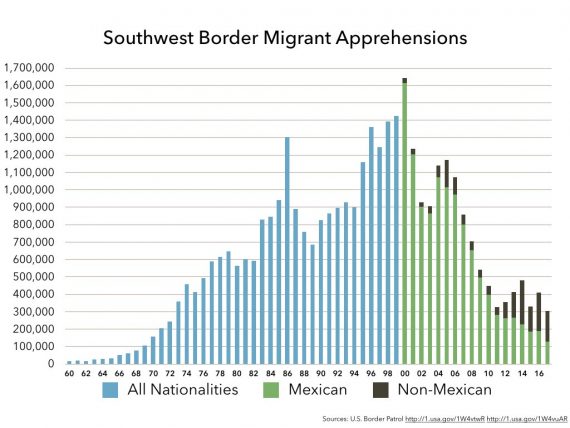

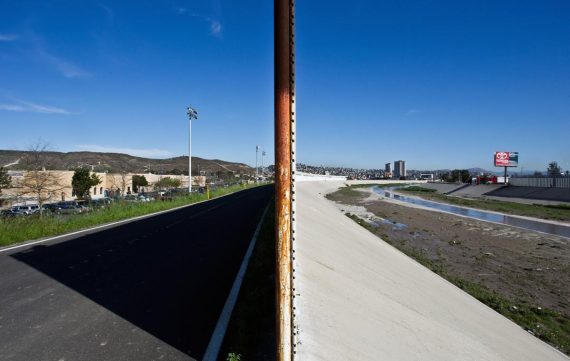
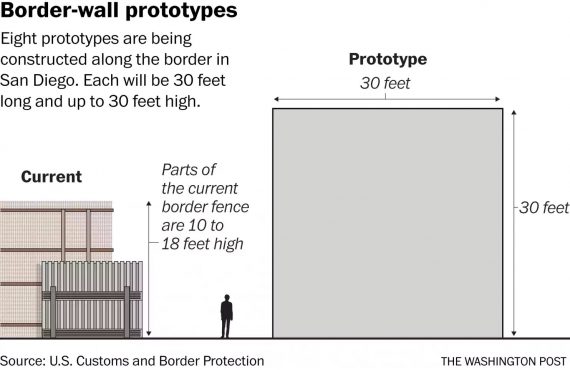



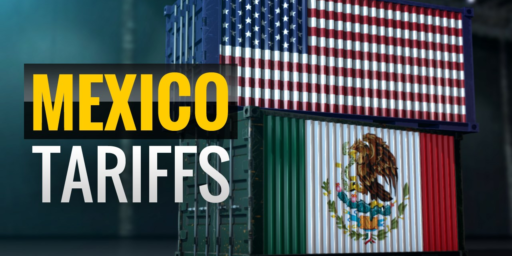


Yes, but a wall sounds good. It’s big. It’s visible. It sends a message. That it won’t work is a minor consideration, or no consideration at all.
Speaking of the wall and Mexico, I am absolutely loving the manner in which former Mexican President Vincente Fox continues to troll Trump on that issue.
It’s only a bad policy if you’re thinking about the US. It’s great policy if you’re an unhinged nut looking for votes from racist ignoramuses.
Excellent piece, Dr. T.
@CSK:
Indeed. And one level that is all it is: message. My prediction, such as it is, is that he will eventually get some portion constructed and that will be his victory. I can envision no outcome in which there is actually a 30-foot high 1954-mile long wall.
@Doug Mataconis: Fox has had some video responses that are as good, or better, than the best political SNL skits.
@Steven L. Taylor: And by “portion” I am thinking some very small amount.
@michael reynolds:
There is that–and thanks.
Another big issue is that a big portion of the US mexico border is the midpoint of Rio Grande River:
1. Do you build on the wall on the US side, effectively ceding territory and (more importantly) water supply to Mexico? Do you annex part of Mexico and build it on their side?
2. The river moves around a lot. Do you keep rebuilding the wall when the river shifts and washes it out? Do you set back to the edge of the floodplain? What happens to the land owners you’ve just cut off from big chunks of the their land?
What @michael reynolds: said. The Wall worked. It helped get Trump elected.
Of course it’s stupid as policy. And now that he’s President*, that’s a little awkward. But his thought process never went that far. He expects to lie about it (in the same way you or I expect to breath), and he’ll probably be successful with his base.
Alec Baldwin had it right last night,
@Stormy Dragon: Indeed. Actually, you probably build it away from the river, thus trapping significant amounts of private property on the other side. This has already happened with some of the fencing.
@Stormy Dragon:
In the Big Bend area the Mexican side shore is a very high and steep cliff, the river is pretty inaccessible from the Mexican side to anyone who is not a well equipped and skilled rock climber. Hard to see where there is any point to a wall along there.
As one who has climbed out of a *1,214′ deep pit*, I feel pretty certain I could handle 30′ of wall.
**Sotano de las Gollandrinas
@OzarkHillbilly: I was thinking about this: surely some not especially sophisticated rope-ladder technology could thwart any of the prototypes. Especially if there were people on both side of the wall. The notion that the wall will stop all crossings is ludicrous.
@Steven L. Taylor: Cavers deal with these kinds of problems on a regular basis and we have the tools and techniques to adapt to just about any problem. When we come across a problem unsuited to present techniques/tools, we create new ones for the new insurmountable obstacle. Cavers are not unique in this talent. This is what people do. History is full of examples of such.
For an enjoyable walk down memory lane, it’s worth recalling what J-E-N-O-S was saying about Trump’s Mexico pledge in early 2016. He kept quoting Scott Adams, describing Trump as a master manipulator playing the long game in a way his critics couldn’t fathom, in which the Mexico claim was simply a bit of a bluster he was using as the opening move in a negotiation where he’d ultimately extract real concessions from Mexico:
For Democrats, one of the few pleasures of the Trump presidency is watching how completely his supporters’ lame attempts to come up with rationalizations for his absurd promises get obliterated by reality.
most illegal immigrants didn’t get here by sneaking across the border.
But the Party of Stupid doesn’t give a shit about your stupid LIEbral facts.
we need 3 walls. one to build around Bungle’s house. one to build around Goonari’s house. and one to build around Tiny Mind 0.0000000000000001’s house.
The bulwarks will reach the outer boundries of the exosphere. Some 6200 miles above sea level. The structures will be slathered on both sides with lard fresh out of a donut fryer (370 deg. F).
These will be the prototypes used to see how quickly a beautiful transparent wall* can be erected around Mar-A-Lago while Trump is entertaining Adult Film Stars some weekend.
*(Pud has contended that any wall would have to be transparent — “you need to be able to see through it.”)
Those three are useful, though, by showing that it’s seemingly impossible to find good justifications for the words and actions of Trumpers and the GOP.
@Kylopod:
Dedicated Trumpkins haven’t abandoned them, though. They still believe–or purport to believe–that he’s a genius playing the long game.
Steven, you’re fighting the good fight, but I hope you realize that all this effort is being directed towards those who can be swayed by facts and reality, i.e. not modern Republicans, not the vast majority of self identified conservatives, and of course, certainly not Trump supporters. None of these groups ingest anything but mindless slogans and, as they have proven again and again, they are completely immune to actual facts.
@Doug Mataconis:
Fox ought to be invited to host SNL. And he ought to accept. They’ve had politicians before. In the 80s, Mayor Ed Koch hosted at least once.
On a more serious note, when has a country ever paid for boondoggles in another country?
@CSK:
Of course. In fact, I don’t have any doubt there are people out there who believe Trump has already built the wall and Mexico has already paid for it. It would go along with the woman who claimed to be benefiting from Trumpcare before President Trump had taken any actions on health care.
Still, it’s a safe bet that if J-E-N-O-S were to pop up again, he wouldn’t be bringing up his ambitious predictions about Trump bringing Mexico to the bargaining table. Instead, he’d do everything he could to make people forget he ever said those things. Just like MBunge never brings up the Carrier deal anymore. That’s what’s amusing about listening to Trump defenders: even if they don’t notice it themselves, their pretzel-like contortions are obvious to everyone else.
@Kylopod:
“Pretzel-like” doesn’t even begin to describe it. In fact, amongst the type of Trump supporter that thought pizza-gate was brave journalism the latest theory seems to be that Trump engaged in things that look like obstruction of justice specifically so he could bring Mueller on. This blind was necessary to cover up what Mueller is really investigating: the Deep State machinations of corrupt government officials and, of course, Hillary Clinton. He will shortly be indicting all kinds of Democrats while completely exonerating Trump. All this trickery is of course necessary to thwart Deep State sabotage.
@MarkedMan: That reminds me of one of my favorite OJ conspiracy theories: the one that says Nicole’s real killer wasn’t OJ himself but rather OJ’s son Jason. There was a whole documentary postulating this theory some years back. What I love about it is that it provides a neat explanation for something that OJ deniers never have seemed able to explain, which was that OJ has always acted, well, guilty, including all his quasi-confessions like the withdrawn book If I Did It or his statement in an interview that he didn’t kill her but if he had it would have been “because I loved her so much.” Under the Jason theory, the reason he’s acted this way is clear: he’s covering up for his son.
You know a conspiracy theory has jumped the shark when it starts positing things that undermine the very reason for there to be a conspiracy theory in the first place.